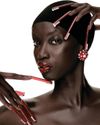
Conceived as a playhouse for adults, Cara Delevingne’s 1940s white-brick home in Los Angeles is the stuff of design-world lore. It brims with madcap furnishings, each corner appointed with her signature wit and imagination. There’s a tented poker room draped in red velvet, a David Bowie–themed bathroom, a ball pit with circus-stripe walls, trampolines laid into the lawn.
When I arrive at the big blue front doors on a cloudless day in late January, Delevingne greets me with a warm hug. She has the gawky charm of a teenage music nerd—barefoot and dressed in an oversized vintage Prince T-shirt matched with gray marl gym shorts—and ushers me quickly past the crystal clear baby grand piano and the glowing James Turrell art installation up to the den on the first floor. If each room reflects a side of her personality, then this space suggests Delevingne at her most introspective. Decorated with little more than a few graphic Bowie concert posters, it’s the one room where the famously kinetic British model and actor might occasionally sit still. “Did you feel the earthquake last night?” she asks, referring to the 4.2 magnitude shock waves that struck off the coast of Malibu in the early hours of the morning. I confess I slept through it, and I’m surprised that she didn’t as well. Could anything rock the foundations of this fantastical bachelorette pad? “They don’t really scare me much,” she says dryly, of earthquakes, sinking her gangly limbs into the sofa and curling up with her dogs— one a Pomeranian husky named Leo, the other a Chihuahua terrier called Alfie. “I guess I’m just always ready for the ground to fall beneath my feet.”
هذه القصة مأخوذة من طبعة April 2023 من Vogue US.
ابدأ النسخة التجريبية المجانية من Magzter GOLD لمدة 7 أيام للوصول إلى آلاف القصص المتميزة المنسقة وأكثر من 9,000 مجلة وصحيفة.
بالفعل مشترك ? تسجيل الدخول
هذه القصة مأخوذة من طبعة April 2023 من Vogue US.
ابدأ النسخة التجريبية المجانية من Magzter GOLD لمدة 7 أيام للوصول إلى آلاف القصص المتميزة المنسقة وأكثر من 9,000 مجلة وصحيفة.
بالفعل مشترك? تسجيل الدخول

FINAL CUT
\"WE WANT YOU TO GO FOR IT!\" ANNA TOLD ME

SCREEN TIME
Three films we can't wait to see.

Impossible Beauty
Sometimes, more is more: Surreal lashes and extreme nails put the fierce back in play

Blossoms Dearie
Dynamic, whimsical florals and the humble backdrops of upstate New York make for a charming study in contrasts.

HOME
Six years ago, Marc Jacobs got a call about a house designed by Frank Lloyd Wright. Making it his own, he writes, would be about love, commitment, anxiety, patience, struggle, and, finally, a kind of hard-fought, hard-won peace.

GIRL, INTERRUPTED
Anna Weyant found extraordinary fame as an artist before she had reached her mid-20s. Then came another kind of attention. Dodie Kazanjian meets the painter at the start of a fresh chapter

ROLE PLAY
Kaia Gerber is someone who likes to listen, learn, read books, go to the theater, ask questions, have difficult conversations, act, perform, transform, and stretch herself in everything she does. That she's an object of beauty is almost beside the point.

CALLAS SHEET
Maria Callas's singular voice made her a legend on the stage. In a new film starring Angelina Jolieand on the runwaysthe romance continues.

BOOK IT
A preview of the best fiction coming

GLOBAL VISTAS
Three new exhibitions offer an expansive view.